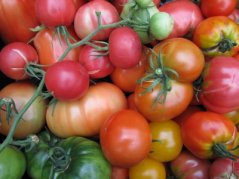
CGN tomato collection
In 1999 the original name Solanum lycopersicum (Heiser and Anderson 1999) has been reintroduced. Rick (1976) proposed earlier to divide the genus Lycopersicon into two subgenera, the ‘lycopersicum complex’ and the ‘peruvianum complex’ (Taylor and Al-Kummer 1982; Heuvelink 2004).
The ‘lycopersicum complex’ consists of the six Solanum species S. lycopersicum, S. pimpinellifolium, S. cheesmaniae, S. neorickii, S. chmielewskii, S. habrochaites and S.pennellii, that can be “easily” crossed with cultivated tomato. S. peruvianum and S. chilense, which have low ability to cross with Solanum lycopersicum, belong to the latter complex.
History
The history of the tomato collection is analog to the other CGN collections of pepper, eggplant, cucumber and melon and described in the general page of the fruit vegetables.
Composition
The collection includes about 1300 accessions and consists mainly of cultivars. The largest part of the collection is formed by the cultivated species Solanum lycopersicum. Most varieties come from Europe, USA and Canada and Russia. The landraces originate from countries all over the world. The wild species originate mainly from Peru and Ecuador.
Maintenance
To be incorporated in the collection, accessions need to have a minimum seed viability of 80% for cultivated material and 60% for accessions of wild species. Regeneration is carried out when seed viability is too low or when the remaining seed quantity has dropped below 1.0 g.
Regeneration/multiplication takes place in insect-free glasshouses on a substrate system where the stems are grown along ropes. Seven plants are used to regenerate self-fertilising tomato. Exceptions are heterogeneous accessions and outcrossing species like S. peruvianum of which at least 10 plants per accession are hand pollinated with a mixture of pollen. When samples are heterogeneous, fourteen plants are used.
Breeding companies, organised in Plantum NL, assist in the regeneration of tomato. Some accessions which are difficult to regenerate are put in isolation cages with bumble bees for pollination. During the growing season plants are monitored by the Dutch Plant Health Service for seed borne diseases in order to prevent seed contamination. Special attention is given to tomato where visual checks and leaf tests are performed for the presence of seed-borne viruses and bacteria (e.g. Clavibacter michiganensis spp. michiganensis, Xanthomonas campestris pv. vesicatoria and Pepino Mosaic Virus (PepMV).

Characterisation
Characterisation of fruit vegetables takes place during regeneration. Almost all accessions have been morphologically described. Until 2006 about 30 descriptors were used for each crop. Since 2006 the fruit vegetables are characterised by minimum descriptors developed by the ECPGR Working Groups. The minimum descriptor lists consist of about ten descriptors per crop and can be found at the ECPGR Solanacaeae webpage. All characterisation data are made available on-line and in downloadable files.
The collections are well photo-documented, many pictures of (un)ripe fruits, plant and flowers are available. When necessary new pictures will be taken during regeneration and added to the CGN website.
Evaluation
Substantial parts of the tomato collection were screened for resistance to Tobacco Mosaic Virus (TMV), Pepino Mosaic Virus, Leaf mould (Cladosporium fulvum), Fusarium wilt (Fusarium oxysporum), Late blight (Phytophthora infestans), Didymella stem rot (Didymella lycopersici), Powdery mildew (Oidium lycopersicum) and Bacterial canker (Clavibacter michiganense subsp. michiganensis).